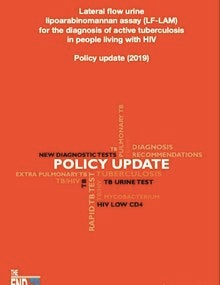Overview
The World Health Organization’s (WHO’s) strategy for tuberculosis (TB) prevention, care and control for 2015–2035 (known as the End TB Strategy) prioritizes the early diagnosis of TB. This prioritization includes cases of smear-negative disease, which are often associated with coinfection with HIV and with young age. In 2017, an estimated 0.9 million (9%) of the 10.0 million people who developed TB worldwide were HIV-positive. The WHO African Region accounted for 72% of the estimated number of HIV-positive incident TB cases.
Tests based on the detection of mycobacterial lipoarabinomannan (LAM) antigen in urine have emerged as potential point-of-care tests for TB. The currently available urinary LAM assays have suboptimal sensitivity, and are therefore not suitable as diagnostic tests for TB in all populations. However, unlike traditional diagnostic methods, urinary LAM assays demonstrate improved sensitivity for the diagnosis of TB among individuals coinfected with HIV. The estimated sensitivity is even greater in patients with lower CD4 cell counts.
The WHO Global TB Programme convened a Guideline Development Group meeting in 2015 to review the evidence for the use of lateral flow urine lipoarabinomannan assay (LF-LAM). The current document provides the background, justification and objectives for the revision of WHO policy on LF-LAM. It provides details on the index test (AlereLAM) being assessed. It also describes the process of evidence retrieval, quality assessment and grading; formulation of the recommendations; and GDG decision-making. Finally, the document presents policy recommendations and related remarks.
|

